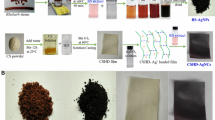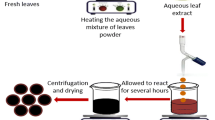Abstract
The synthesis of silver nanoparticles (AgNPs) using a Stevia rebaudiana aqueous extract and their dispersion in starch in order to obtain starch/AgNps nanocomposites are shown in this study. The AgNPs and the starch/AgNPs nanocomposites have been characterized by ultraviolet–visible spectroscopy, optical microscopy, high-resolution transmission electron microscopy, scanning electron microscopy, X-ray diffraction, differential scanning calorimetry and thermogravimetric analysis. Furthermore, the interaction of starch/AgNPs nanocomposites with a MCF-7 breast cancer cell line is analyzed. AgNPs with an average size around 15–20 nm have been obtained. starch/AgNPs nanocomposite morphology changes with the content of silver (3, 5 and 8 mM), from totally separated and dispersed nanoparticles to ribbon-type morphology. The diffraction pattern of the starch/AgNPs-3 nanocomposite indicates the formation of silver chloride nanoparticles (AgClNPs). A cytotoxic behavior of starch/AgNPs-3 nanocomposite on MCF-7 cancer cells with less damage to normal cells is observed. Hence, the high dispersion of the AgNPs or AgClNPs in starch could be influencing the selective cytotoxic behavior. Thus, this study proposes the generation of biocompatible composite materials, with AgNPs immobilized on starch. These materials have selective action against breast cancer cells, where the selectivity is controlled through the AgNPs dispersion on the biopolymer.










Similar content being viewed by others
References
Mittal AK, Chisti Y, Banerjee UC (2013) Synthesis of metallic nanoparticles using plant extracts. Biotechnol Adv 31:346–356
Akhtar MS, Panwar J, Yun YS (2013) Biogenic synthesis of metallic nanoparticles by plant extracts. ACS Sustain Chem Eng 1:591–602
Vijayaraghavan K, Ashokkumar T (2017) Plant-mediated biosynthesis of metallic nanoparticles: a review of literature, factors affecting synthesis, characterization techniques and applications. J Environ Chem Eng 5:4866–4883
Sood R, Chopra DS (2018) Metal-plant frameworks in nanotechnology: an overview. Phytomedicine 50:148–156
Zheng K, Setyawati MI, Leong DT, Xie J (2018) Antimicrobial silver nanomaterials. Coordin. Chem Rev 357:1–17
Rai M, Yadav A, Gade A (2009) Silver nanoparticles as a new generation of antimicrobials. Biotechnol Adv 27:76–83
Hemmati S, Rashtiani A, Zangeneh MM, Mohammadi P, Zangeneh A, Veisi H (2019) Green synthesis and characterization of silver nanoparticles using Fritillaria flower extract and their antibacterial activity against some human pathogens. Polyhedron 158:8–14
Jha D, Thiruveedula PK, Pathak R, Kumar B, Gautam HK, Agnihotri S, Sharma AK, Kumar P (2017) Multifunctional biosynthesized silver nanoparticles exhibiting excellent antimicrobial potential against multi-drug resistant microbes along with remarkable anticancerous properties. Mat Sci Eng C-Mater 80:659–669
Ahmadian E, Dizaj SM, Rahimpour E, Hasanzadeh A, Eftekhari A, Zadegan HH, Halajzadeh J, Ahmadian H (2018) Effect of silver nanoparticles in the induction of apoptosis on human hepatocellular carcinoma (HepG2) cell line. Mat Sci Eng C-Mater 93:465–471
Yeasmin S, Datta HK, Chaudhuri S, Malik D, Bandyopadhyay A (2017) In-vitro anti-cancer activity of shape controlled silver nanoparticles (AgNPs) in various organ specific cell lines. J Mol Liq 242:757–766
Ajitha B, Reddy YAK, Jeon HJ, Ahn CW (2018) Synthesis of silver nanoparticles in an eco-friendly way using Phyllanthus amarus leaf extract. Antimicrobial and catalytic activity. Adv Powder Technol 29:86–93
Maddinedi SB, Mandal BK, Maddili SK (2017) Biofabrication of size controllable silver nanoparticles—a green approach. J Photochem Photobiol B 167:236–241
Ceunen S, Geuns JMC (2013) Steviol glycosides: chemical diversity, metabolism, and function. J Nat Prod 76:1201–1228
Gregersen S, Jeppesen PB, Holst JJ, Hermansen K (2004) Antihyperglycemic effects of stevioside in type 2 diabetic subjects. Metabolism 53:73–76
Boonkaewwan C, Toskulkao C, Vongsakul M (2006) Anti-inflammatory and immunomodulatory activities of stevioside and its metabolite steviol on THP-1 cells. J Agric Food Chem 54:785–789
Ghanta S, Banerjee A, Poddar A, Chattopadhyay S (2007) Oxidative DNA damage preventive activity and antioxidant potential of Stevia rebaudiana (Bertoni) Bertoni, a natural sweetener. J Agric Food Chem 55:10962–10967
Chatsudthipong V, Muanprasat C (2009) Stevioside and related compounds: therapeutic benefits beyond sweetness. Pharmacol Therapeut 121:41–54
Sadeghi B, Mohammadzadeh M, Babakhani B (2015) Green synthesis of gold nanoparticles using Stevia rebaudiana leaf extracts: characterization and their stability. J Photochem Photobiol B 148:101–106
Alijani HQ, Pourseyedi S, Mahani MT, Khatami M (2019) Green synthesis of zinc sulfide (ZnS) nanoparticles using Stevia rebaudiana Bertoni and evaluation of its cytotoxic properties. J Mol Struct 1175:214–218
Khatami M, Alijani HQ, Heli H, Sharifi I (2018) Rectangular shaped zinc oxide nanoparticles: green synthesis by Stevia and its biomedical efficiency. Ceram Int 44:15596–15602
Yilmaz M, Turkdemir H, Kilic MA, Bayram E, Cicek A, Mete A, Ulug B (2011) Biosynthesis of silver nanoparticles using leaves of Stevia rebaudiana. Mater Chem Phys 130:1195–1202
Bujak T, Niziol-Lukaszewska Z, Gawel-Beben K, Seweryn A, Kucharek M, Rybczynska-Tkaczyk K, Matysiak M (2015) The application of different Stevia rebaudiana leaf extracts in the “green synthesis” of AgNPs. Green Chem Lett Rev 8:78–87
Cheviron P, Gouanvé F, Espuche E (2014) Green synthesis of colloid silver nanoparticles and resulting biodegradable starch/silver nanocomposites. Carbohyd Polym 108:291–298
Ji N, Liu C, Zhang S, Xiong L, Sun Q (2016) Elaboration and characterization of corn starch films incorporating silver nanoparticles obtained using short glucan chains. LWT-Food Sci Technol 74:311–318
Sur S, Rathore A, Dave V, Reddy KR, Chouhan RS, Sadhu V (2019) Recent developments in functionalized polymer nanoparticles for efficient drug delivery systems. Nano-Struct Nano-Objects 20:100397
Paliwal S, Tilak A, Sharma J, Dave V, Sharma S, Verma K, Tak K, Reddy KR, Sadhu V (2019) Flurbiprofen-loaded ethanolic liposome particles for biomedical applications. J Microbiol Methods 161:18–27
Dave V, Tak K, Sohgaura A, Gupta A, Sadhu V, Reddy KR (2019) Lipid-polymer hybrid nanoparticles: synthesis strategies and biomedical applications. J Microbiol Methods 160:130–142
Patil SB, Inamdar SZ, Reddy KR, Raghu AV, Soni SK, Kulkarni RV (2019) Novel biocompatible poly(acrylamide)-grafted-dextran hydrogels: synthesis, characterization and biomedical applications. J Microbiol Methods 159:200–210
Boppana R, Raut SY, Mohan GK, Sa B, Mutalik S, Reddy KR, Das KK, Biradar MS, Kulkarni RV (2019) Novel pH-sensitive interpenetrated network polyspheres of polyacrylamide-g-locust bean gum and sodium alginate for intestinal targeting of ketoprofen: in vitro and in vivo evaluation. Colloids Surf B 180:362–370
Gulla S, Lomada D, Srikanth VVSS, Shankar MV, Reddy KR, Soni S, Reddy MC (2019) Chapter 11: recent advances in nanoparticles-based strategies for cancer therapeutics and antibacterial applications. Method Microbiol 46:255–293
Dave V, Gupta A, Singh P, Gupta C, Sadhu V, Reddy KR (2019) Synthesis and characterization of celecoxib loaded PEGylated liposome nanoaprticles for biomedical applications. Nano-Struct Nano-Objects 18:100288
Doyle LA, Yang W, Abruzzo LV, Krogmann T, Gao Y, Rishi AK, Ross DD (1998) A multidrug resistance transporter from human MCF-7 breast cancer cells. Proc Natl Acad Sci 95:15665–15670
Comsa S, Cimpean AM, Raica M (2015) The story of MCF-7 breast cancer cell line: 40 years of experience in research. Anticancer Res 35:3147–3154
Jeyaray M, Sathishkumar G, Sivanandhan G, MubarakAli D, Rajesh M, Arun R, Kapildev G, Manickavasagam M, Thajuddin N, Premkumar K, Ganapathi A (2013) Biogenic silver nanoparticles for cancer treatment: an experimental report. Colloid Surf B 106:86–92
Jannathul FM, Lalitha P (2015) Apoptotic efficacy of biogenic silver nanoparticles on human breast cancer MCF-7 cell lines. Prog Biomater 4:113–121
Hsin YH, Chen CF, Huang S, Shih TS, Lai PS, Chueh PJ (2008) The apoptotic effect of nanosilver is mediated by a ROS-and JNK-dependent mechanism involving the mitochondrial pathway in NIH3T3 cells. Toxicol Lett 179:130–139
Ahluwalia V, Elumalai S, Kumar V, Kumar S, Sangwan RS (2018) Nano silver particle synthesis using Swertia paniculata herbal extract and its antimicrobial activity. Microb Pathog 114:402–408
Kelly KL, Coronado E, Zhao LL, Schatz GC (2003) The optical properties of metal nanoparticles: the influence of size, shape, and dielectric environment. J Phys Chem B 107:668–677
Liz-Marzán LM (2004) Nanometals formation and color. Mater Today 7:26–31
Jin R, Cao YW, Mirkin CA, Kelly KL, Schatz GC, Zheng JG (2001) Photoinduced conversion of silver nanospheres to nanoprisms. Science 294:1901–1903
Wiley BJ, Im SH, Li ZY, McLellan J, Siekkinen A, Xia Y (2006) Maneuvering the surface Plasmon resonance of silver nanostructures through shape-controlled synthesis. J Phys Chem B 110:15666–15675
Tang B, Li J, Hou X, Afrin T, Sun L, Wang X (2013) Colorful and antibacterial silk fiber from anisotropic silver nanoparticles. Ind Eng Chem Res 52:4556–4563
Ghosh PR, Fawcett D, Sharma SB, Poinern GEJ (2017) Production of high-value nanoparticles via biogenic processes using aquacultural and horticultural food waste. Materials 10:852
Molina-Calle M, Priego-Capote F, Luque de Castro MD (2017) Characterization of stevia leaves by LC-QTOF MS/MS analysis of polar and non-polar extracts. Food Chem 219:329–338
Lemus-Mondaca R, Vega-Gálvez A, Zura-Bravo L, Ah-Hen K (2012) Stevia rebaudiana Bertoni, source of a high-potency natural sweetener: a comprehensive review on the biochemical, nutritional and functional aspects. Food Chem 132:1121–1132
Mashwani ZR, Khan MA, Khan T, Nadhman A (2016) Applications of plant terpenoids in the synthesis of colloidal silver nanoparticles. Adv Colloid Interface Sci 234:132–141
Abreu AS, Oliveira M, de Sá A, Rodrigues RM, Cerqueira MA, Vicente AA, Machado AV (2015) Antimicrobial nanostructured starch based films for packaging. Carbohy Polym 129:127–134
Jinu UU, Rajakumaran S, Senthil-Nathan S, Geetha N, Venkatachalam P (2018) Potential larvicidal activity of silver nanohybrids synthesized using leaf extracts of Cleistanthus collinus (Roxb.) Benth. Ex Hook.f. and Strychnos nux-vomica L. nux-vomica against dengue, Chikungunya and Zika vectors. Physiol Mol Plant Pathol 101:163–171
Nayak D, Pradhan S, Ashe S, Rauta PR, Nayak B (2015) Biologically synthesised silver nanoparticles from three diverse family of plant extracts and their anticancer against epidermoid A431 carcinoma. J Colloid Interface Sci 457:329–338
Patil MP, Singh RD, Koli PB, Patil KT, Jagdale BS, Tipare AR, Kim GD (2018) Antibacterial potential of silver nanoparticles synthesized using Madhuca longifolia flower extract as a green resource. Microb Pathog 121:184–189
Kawata K, Osawa M, Okabe S (2009) In vitro toxicity of silver nanoparticles at noncytotoxic doses to HepG2 human hepatoma cells. Environ Sci Technol 43:6046–6051
Chairuangkitti P, Lawanprasert S, Roytrakul S, Aueviriyavit S, Phummiratch D, Kulthong K, Chanvorachote P, Maniratanachote R (2013) Silver nanoparticles induce toxicity in A549 cells via ROS-dependent and ROS-independent pathways. Toxicol In Vitro 27:330–338
Dasgupta N, Ranjan S, Mishra D, Ramalingam C (2018) Thermal co-reduction engineered silver nanoparticles induce oxidative cell damage in human colon cancer cells through inhibition of reduced glutathione and induction of mitochondria-involved apoptosis. Chem Biol Interact 295:109–118
Lee KJ, Nallathamby PD, Browning LM, Osgood CJ, Xu XHN (2007) In vivo imaging of transport and biocompatibility of single silver nanoparticles in early development of Zebrafish embryos. ACS Nano 1:133–143
Carlson C, Hussain SM, Schrand AM, Braydich-Stolle LK, Hess KL, Jones RL, Schlager JJ (2008) Unique cellular interaction of silver nanoparticles: size-dependent generation of reactive oxygen species. J Phys Chem B 112:13608–13619
Acknowledgements
This work was partly supported by the PRODEP-SEP of Mexico [Grant Number DSA/103.5/15/11097].
Author information
Authors and Affiliations
Corresponding author
Additional information
Publisher's Note
Springer Nature remains neutral with regard to jurisdictional claims in published maps and institutional affiliations.
Rights and permissions
About this article
Cite this article
Valera-Zaragoza, M., Huerta-Heredia, A.A., Peña-Rico, M.A. et al. Morphological, structural and cytotoxic behavior of starch/silver nanocomposites with synthesized silver nanoparticles using Stevia rebaudiana extracts. Polym. Bull. 78, 1683–1701 (2021). https://doi.org/10.1007/s00289-020-03184-6
Received:
Revised:
Accepted:
Published:
Issue Date:
DOI: https://doi.org/10.1007/s00289-020-03184-6




